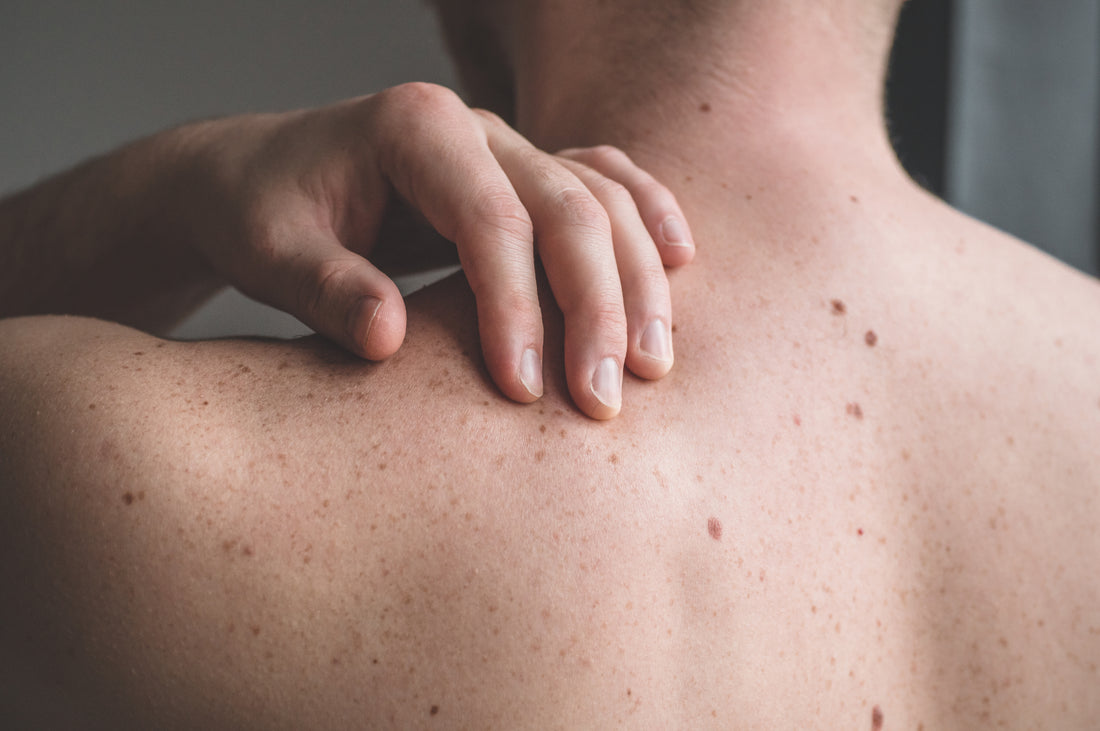
A Nerdie Guide to Moles & Sun Safety
Holey moley, who knew moles came in so many forms? Brown, black, hairy, raised, large, small. They're just as unique as the hooman who wears them. We all have moles, but do you know how to protect them in the sun? Are you regularly checking them?
Just like our skin, it’s oh-so-important that we protect our moles when the sun’s rays are beating down – or even if it’s raining, hailing or snowing for that matter. SPF that protects against UV rays is essential for skin on each and every one of the 365 days of the year, or 366 days if it’s a leap year. It’s even more of a hot topic at Nerd HQ in the warmer months considering we’re likely to be spending plenty of time in the great outdoors where we tend to have more skin on show.
Therefore, we feel like it’s our nerdie duty to educate all hoomans on the importance of moles and sun safety. Most moles are completely benign (read: non-dangerous and non-cancerous), but it's important to understand what to look out for when checking moles for anything out of the ordinary.
Moles & Sun Safety
What are moles?
Moles, we’ve all got ‘em. Some people have loads, others have a few. If you’re an alien with no moleys to call your own, they’re the little coloured dots that can be found all over a hooman’s body. Moles can be present at birth or develop during childhood and adolescence, right through to adulthood. They can also lighten or darken over time. Nerdie fact: the technical term for moles is nevus, multiple moles are nevi, which comes from the Latin word for birthmark.
But what are they really? A mole is the result of mutations within melanocytes which causes the cells to grow in a cluster instead of being spread evenly across our skin. Melanocytes are melanin (aka pigment) producing skin cells which is why our moles can range in colour from matching your skin tone to pink or blue, dark brown or black. Interestingly, moles don’t always have pigment.
Most moles are completely harmless, but they can become malignant if the melanocytes continue to mutate. The DNA damage to melanocytes can be caused by prolonged exposure to UVA and UVB rays. If the melanocytes proliferate further, there’s the risk that the moles can develop into pre-cancerous lesions or melanoma.
More nerdiness: Why You Need SPF Indoors
What is melanoma? Who is most at risk?
Melanoma is a type of skin cancer that develops in melanocytes. In 2012, melanoma accounted for 1.6% of all cancers worldwide, with its occurrence on the rise. The most common sign of melanoma is a new mole or a change in an existing mole – so mole mapping is a smart idea. Crucially, not all melanoma starts in moles which is why it’s important to keep an eye out for changing skin lesions.
Anyone can get melanoma, which is why all hoomans should remain vigilant of any skin changes. Having said that, there are a few risk factors which can increase the chance of developing melanoma. Notably, if you fall into categories 1, 2 or 3 on the Fitzpatrick scale, if you have red hair or blonde hair, freckly skin, or if you’re a moley person.
Interestingly, it presents differently in different hoomans. Women tend to develop melanoma on their legs, while men commonly get it on their torsos. It’s harder to detect in dark-skinned hoomans as it tends to appear under fingernails or toenails, on the soles of their feet or palms – areas that aren’t sun-exposed. Repeated, severe blistering sunburns before the age of eighteen can also cause melanoma later in life. There’s also a genetic risk to melanoma, which means you’re more likely to get it if your parents have suffered from it.
More nerdiness: Choosing The Right Everyday SPF For Your Skin
How do I protect moles in the sun?
Children in Australian are taught to slip, slop, slap, seek and slide. To translate: slip on a shirt, slop on some broad-spectrum SPF 50, slap on a hat, seek shade and slide on some sunglasses. I think it’s a great way to remember the steps we should all be taking to protect our skin and moles from sun damage.
To apply the perfect amount of SPF, I find it helpful to think of teaspoon servings: apply ½ teaspoon to your face, neck and ears, ½-1 teaspoon for each arm, 1-2 teaspoons for each leg, 1-2 teaspoons for your back and 1-2 teaspoons for your chest and abdomen. The amount you apply will depend on whether you’re a tall or small hooman, and children require much less than what I’ve specified.
The Irish Cancer Society recommend that you should reapply your SPF every 2 hours in their SunSmart Code. Even more so if you’ve been dipping in and out of a pool (lucky!) or sweating a lot. I would also say to stay in the shade between 10am-2pm as that’s when the sun is highest (and strongest) in the sky.
Finally, avoid sunbeds like the plague. They're the ultimate skin sin and fake tan will deliver a better glow without the risk of serious damage to your skin and premature ageing.

How do I check my moles?
Checking your moles is as easy as your ABC’s... or ABCDE’s where moles are concerned. The “ABCDE” method is a super simple way to check if there’s anything peculiar about your moles. It's advised that you should check your moles once a month and visit your GP if you notice any of the following changes:
A = Asymmetry: is your mole asymmetrical? If not, we advise that you visit your GP.
B = Borders: does your mole have an uneven border? A mole with an uneven border should be seen by a GP.
C = Colour: does your mole have more than one colour? Moles with two or more moles should be shown to your doctor.
D = Diameter: does your mole have a large diameter? Moles with a diameter of 5mm or more should be shown to a doctor.
E = Elevation: is your mole raised? Raised moles should be seen by a GP.
F = Firm: is your mole firm? Hard moles should be seen by a GP.
G = Growing: Is your mole getting bigger? If it’s growing, you should show your mole to your GP.
What do I do if I’ve found an “ugly duckling” mole?
An ugly duckling mole is a lesion that doesn’t look like the others. Please try not to worry if you’ve found an ugly duckling or noticed any changes in your moles after checking them – most moles are harmless and completely normal. It doesn’t mean that they’re cancerous, it’s just safer to err on the side of caution and detect any abnormalities early.
If you’re an Irish hooman, book an appointment with your GP and they’ll refer you to a specialist in hospital if they suspect it’s melanoma. The NHS in the UK follows a similar process, you’ll be referred to a hospital within 2 weeks by your GP if they think it’s necessary. They’ll check your moles with a specific lens known as a dermatosope which magnifies the cells with great specificity. After testing your mole, they can then remove the lesion if it’s malignant.
Check out our professionally-curated range of SPF products if you need to stock up on sun protection – it's a skin-vestment. Or book an online skin consultation with one of our expert team of Nerds at Skin Nerd Network for advice and product recommendations that are unique to you and your skin.
Sources:
What’s New in Melanoma Skin Cancer Research? American Cancer Society. 8th June 2021, from https://www.cancer.org/cancer/melanoma-skin-cancer/about/new-research.html.
Overview of Melanoma. Melanoma UK. 22nd May 2021, from https://www.melanomauk.org.uk/overview-of-melanoma.
The 'ABCDE' Rule. Melanoma UK. 29th May 2021, from https://www.melanomauk.org.uk/the-abcde-rule.
SunSmart Code. Irish Cancer Society. 30th May 2021, from https://www.cancer.ie/cancer-information-and-support/cancer-types/skin-cancer/sunsmart-code.
